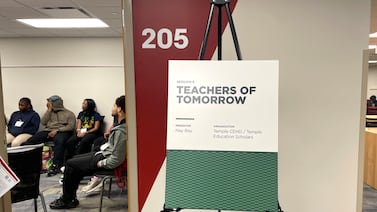Chalkbeat is a nonprofit news organization covering public education in communities across America. Subscribe to our free Colorado newsletter to keep up with education news from around the state: ckbe.at/subscribe-colorado
Homeowners in the 27J school district might have been better off paying a higher property tax rather than allowing the district to adopt a four-day school week, a new study suggests.
Preliminary results of the study, which has not yet been peer reviewed, suggest that home prices suffered and student achievement in the district may have dropped. Teacher retention, which the district cited as the main reason for moving to the four-day school week, may also have decreased, according to the study.
The 27J school district, which serves more than 22,600 students this year, is based north of Denver, covering Brighton and parts of Commerce City and Thornton. Leaders rolled out the four-day school week in the fall of 2018, after having failed a sixth time to pass a local tax increase to pay teachers more.
District Superintendent Chris Fiedler disputes the findings, citing higher-than-ever graduation rates and lower overall teacher turnover.
The authors of the study acknowledge there were limitations in the way they examined student achievement and teacher retention pieces. They didn’t want to look at years affected by COVID, so they only examined student achievement data through the 2019-20 school year. For teacher retention data they examined data through the 2020-21 school year. So it’s possible the findings were short-term impacts, said Frank James Perrone, one of the study’s authors.
When it comes to student achievement, research would ideally track individual students, said Perrone, assistant professor of educational leadership at Indiana University. Since the researchers couldn’t access that level of data, it’s unknown if some of the findings could have been a result of higher-performing students leaving the district.
The research is more comprehensive and based on more data when it comes to the housing findings. While housing prices in 27J haven’t dropped, home values stopped growing at the same rate relative to its most comparable neighboring district. Therefore, homeowners lost out on growth that they likely would have seen without the change, according to the study.
The researchers calculated those losses compared to the cost of paying for the mill levy override and found that, financially, conservative estimates suggest homeowners would have been better off approving the tax measure.
“These results suggest the decision to adopt a 4-day school week in a metropolitan setting should not be taken lightly,” the study states.
Voters should be aware of possible tradeoffs when voting against local tax measures that can drive a district to switch to a four-day school week, Perrone said.
Teacher retention was goal of shorter school week
In years past, 27J has made other drastic changes as a result of the failure to pass local tax measures to increase its revenue. For instance, when the district faced overcrowding and was unable to build new schools, it had to move the high schools to a split schedule from 2015 to 2018. Some students were on campus in the mornings and some attended school later in the day to reduce the amount of people in the school buildings at one time.
This past November, in the eighth attempt to pass a mill levy override, 27J finally succeeded. The measure will allow the district to raise teacher salaries starting this fall. That, together with more funding from the governor’s proposed budget, could get starting pay to $50,000, Fiedler said, but that’s still lower than in many metro area districts.
Fiedler believes that the four-day school week, while an effective incentive for some teachers, is not as effective when the pay gap with other districts grows too wide. He said he hopes next year’s raises will make his district attractive again.
“It is a total tradeoff,” Fiedler said. “That gap eventually becomes so large that it’s not worth the tradeoff.”
Kathey Ruybal, president of the teachers union in the district, said teachers and staff overwhelmingly support the four-day school week. Some staff members opposed to the change left in the first year, but staff who leave now leave because of low pay, she said
According to state data, turnover rates for teachers in 27J have dropped to 14.6% — a lower rate than many neighboring districts. And when compared to the nearly 17% rate in 2017, it’s a drop of 14%. But other nearby districts had steeper drops in turnover rates in the same time period.
For the study, the researchers went deeper, using staff-level data from the state to look at years of experience, salary, and whether teachers had advanced degrees. Teachers with between 5 and 15 years of experience were 5% less likely to return to the district after the four-day switch.
“We can only see experience level, but we don’t have effectiveness ratings,” Perrone said. “It’s possible they kept the best teachers.”
Perrone, who worked on the study with Adam D. Nowak of West Virginia University and Patrick S. Smith of the University of North Carolina at Charlotte, said he hopes other researchers will take another look in the future at how the four-day switch changes the workforce in the long term. How districts use the fifth off day for professional development or whether that gives teachers more planning time might change the culture of the workplace or encourage more effectiveness, he said.
In 27J, teachers have training on one free Monday each month. A second Monday each month is used for principal training and district meetings. That means principals and school leaders rarely have to leave schools for meetings when students are in class, Fiedler said.
Ruybal said she doesn’t think the four-day school week has had much impact on culture or planning time. However, additional planning time during the four-day school week that her union won in negotiations is helpful, she said.
Findings match other research on 4-day school weeks
Traditionally, most four-day school districts have served rural communities. Recently, more large, urban districts have made the switch, including the 14,000-student Independence School District neighboring Kansas City, Missouri. But research that isn’t focused on rural districts is limited — making this study significant as researchers look to better understand the impacts.
Paul Thompson, an associate professor of economics at Oregon State University who reviewed the study, said the academic findings echo what research has found elsewhere: Academic achievement generally declines when schools switch to a four-day week.
The finding, he says, seems related to how much time is actually lost. In districts that make up most of the instructional time, the decline is smaller or not there.
In 27J, Superintendent Fiedler said, the district continued to meet the state’s instructional time requirements by lengthening the school day and eliminating early release or other time off for planning.
Research on four-day school weeks has started looking at impacts beyond test scores, Thompson said.
“Most educational interventions are happening within the schools,” Thompson said. “But there’s many more outcomes that can be affected by this choice.”
Previous research, for example, found an increase in juvenile delinquency in Colorado communities with four-day school weeks, perhaps because teenagers spent more time unsupervised. Looking at the impact on housing makes sense, Thompson said.
Oded Gurantz, an assistant professor at the University of Colorado Boulder, said other research finds that educational policies can have a quick and observable impact on the local housing market.
In the case of 27J’s four-day school week, families may have to consider the cost of child care on the fifth day. Local realtors, including Alan Strange, said they haven’t noticed potential home buyers talking about the four-day week recently, but did notice it when the district rolled out a split schedule for the high school.
With more families working from home since the start of COVID, Strange said, the impact may have since dissipated.
Fiedler said that when the district first moved to four-day weeks, about 1,000 families signed up for the district’s child care option for about $30 per day. Now, only about 300 families use the child care option. In 2020, after the start of COVID, some government agencies including the Adams County government offices, moved to a matching four-day work schedule.
Fiedler agrees that moving to a four-day school week is not a decision to be made lightly.
It was the necessary and right thing to do for his district, he said to Chalkbeat. “We had to do something,” Fiedler said.
But when other school district leaders ask whether he would still make the switch if he had the money to just pay teachers more, his answer is no.
Yesenia Robles is a reporter for Chalkbeat Colorado covering K-12 school districts and multilingual education. Contact Yesenia at yrobles@chalkbeat.org.







